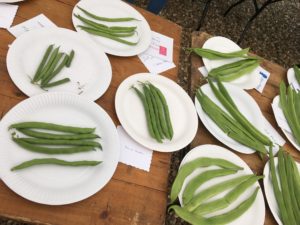17 August 2017
Craft Villages; Plant Villages; Flower, Vegetable and Produce Shows
Country life in the 21st century.
By Lynda Goetz
 The manager of our village pub is a Londoner. His wife is Polish. The idea of competitive entries for ‘A bucket of potatoes (one plant)’, ‘5 runner beans’, ‘3 matching white onions’, ‘a single rose’, ‘2 stems of mop head hydrangeas’ or ‘3 cheese scones’ etc left them both rather bemused. I am sure both know about cling film, but not sure either would know why food items needed to be ‘displayed on a doyley’. They nevertheless entered into the spirit of things and not only allowed the pub to be used for the occasion, but closed it for judging at 10.30am and ‘re-opened to all at 2pm for viewing and prize-giving’.
The manager of our village pub is a Londoner. His wife is Polish. The idea of competitive entries for ‘A bucket of potatoes (one plant)’, ‘5 runner beans’, ‘3 matching white onions’, ‘a single rose’, ‘2 stems of mop head hydrangeas’ or ‘3 cheese scones’ etc left them both rather bemused. I am sure both know about cling film, but not sure either would know why food items needed to be ‘displayed on a doyley’. They nevertheless entered into the spirit of things and not only allowed the pub to be used for the occasion, but closed it for judging at 10.30am and ‘re-opened to all at 2pm for viewing and prize-giving’.
This type of event, along with the village fete, is still viewed as something of a staple of village life around the country. In many places the two are combined, which would appear to be sensible, although declining entries for the competitions have as here led to the occasions being separated in an attempt to focus attention more fully and boost participation. Good organisers are needed, but so too are those willing to participate. This year’s event in our village followed something of a flop last year held in the village hall (more out of the way). It attracted a fair number of entries and a reasonable attendance, including some young families as well as the inevitable older participants and organisers. Most came away with a sense of satisfaction at having been involved in a community effort (if perhaps as bemused as the Londoner about the judgements on the relative merits of raffia-tied onions and miniature floral arrangements in ‘your favourite egg cup’).
 The Taunton Flower Show, first held in 1866 and every year since for two days in early August (apart from during World War II) and apparently claimed by some to be ‘the Chelsea of the West’, is in fact more like a cross between Hampton Court Flower Show and a village event on a grand scale. There is an arena which, depending on the year, stages displays of falconry, stunt teams, motorcycle shows, band parades and exhibitions of sheep dog trials, dog agility presentations or displays of horsemanship; there are stands selling items from wooden-handled brushes (including ones for cleaning out flowerpots which look like mini loo-brushes) handmade somewhere in the world (not in the West Country anyway) to boots, leisure clothing, food and a Bee and Honey marquee. There are a handful of designer gardens; a floral marquee with nurserymen selling everything from air plants and arum lilies to the latest zinias and zonartic pelargoniums; a Plant Village with wonderful collections of flowering perennials in every colour imaginable plus a Craft Village (think ‘Country Living’ marquee with slightly less panache) and a Festival Village with yet more crafts as well as more food and live music. There is also the Competition Marquee where those who want to display their prowess at Victoria sponge making, jam-making or wine-making or exhibit their prize marrows, tomatoes or sweet peas get the chance to do so. Competition entries this year are apparently the highest ever ‘in modern times’. Most who attended felt it was ‘an enjoyable day out’ and a ‘well-organised event’.
The Taunton Flower Show, first held in 1866 and every year since for two days in early August (apart from during World War II) and apparently claimed by some to be ‘the Chelsea of the West’, is in fact more like a cross between Hampton Court Flower Show and a village event on a grand scale. There is an arena which, depending on the year, stages displays of falconry, stunt teams, motorcycle shows, band parades and exhibitions of sheep dog trials, dog agility presentations or displays of horsemanship; there are stands selling items from wooden-handled brushes (including ones for cleaning out flowerpots which look like mini loo-brushes) handmade somewhere in the world (not in the West Country anyway) to boots, leisure clothing, food and a Bee and Honey marquee. There are a handful of designer gardens; a floral marquee with nurserymen selling everything from air plants and arum lilies to the latest zinias and zonartic pelargoniums; a Plant Village with wonderful collections of flowering perennials in every colour imaginable plus a Craft Village (think ‘Country Living’ marquee with slightly less panache) and a Festival Village with yet more crafts as well as more food and live music. There is also the Competition Marquee where those who want to display their prowess at Victoria sponge making, jam-making or wine-making or exhibit their prize marrows, tomatoes or sweet peas get the chance to do so. Competition entries this year are apparently the highest ever ‘in modern times’. Most who attended felt it was ‘an enjoyable day out’ and a ‘well-organised event’.
The bemusement of city-dwellers and foreigners faced with certain aspects of these events is understandable. After all, growing runner beans or raspberries is not easily done in cities. Jam-making or wine-making has never really been a town-dweller’s pursuit – you do not get gluts of blackcurrants or elderberries in city gardens or parks. Watching sheep-dogs round up ducks is probably not fascinating if the only ducks you ever see are the over-fed ones on park ponds and the only dog you are able realistically to keep is a miniature dachshund. For those used to the top-flight performances available in big cities, the Scout Band playing at a local show may not be riveting, but are these sorts of events simply an anachronism in the 21st century or do they remain an essential part of rural life?
 Some 20,000 people visit Vivary Park for what Taunton Horticultural Society claim is the oldest and longest running show of its kind in the UK (although Shrewsbury makes similar claims), but in an era when the bottom line is more important than ever, it looks as if the historic venue will cease to be used after next year because of the charges imposed by the local Council. In spite of the highest ever entries in modern times, the sub-text here is that in pre-modern times (no definition given) the entries were higher. Nowadays there are so many possibilities for entertainment and claims on our time that dedicating hours to domestic or horticultural skills is either denigrated or simply not done. Younger generations appear to have little interest in such activities when they could either be out seeking adrenalin thrills of their own, in the form of, say, wind-surfing or kite-surfing or, failing that, sitting indoors surfing the ‘net or playing bloodthirsty and exciting online games.
Some 20,000 people visit Vivary Park for what Taunton Horticultural Society claim is the oldest and longest running show of its kind in the UK (although Shrewsbury makes similar claims), but in an era when the bottom line is more important than ever, it looks as if the historic venue will cease to be used after next year because of the charges imposed by the local Council. In spite of the highest ever entries in modern times, the sub-text here is that in pre-modern times (no definition given) the entries were higher. Nowadays there are so many possibilities for entertainment and claims on our time that dedicating hours to domestic or horticultural skills is either denigrated or simply not done. Younger generations appear to have little interest in such activities when they could either be out seeking adrenalin thrills of their own, in the form of, say, wind-surfing or kite-surfing or, failing that, sitting indoors surfing the ‘net or playing bloodthirsty and exciting online games.
Plant-growing, bee-keeping or jam-making require patience and consistency, characteristics frequently not attributable to the young. Is it really surprising therefore that efforts to bring in young people to participate in events such as village fetes or local flower shows meet with little enthusiasm? It is usually possible to encourage their involvement until say the age of 10 or 12, but then other interests and activities take over. However, hasn’t it ever been thus? Surely the village worthies were rarely those under forty and were always more likely to have been those older citizens with time on their hands? The former headmistresses with the ability to organise things (as well as other people) did not spring fully formed at eighteen. Perhaps all those in their twenties who now shudder at the thought of competing in a Swiss Roll competition might in time to come see it as worthwhile practice for their entry to ‘Bake Off’ or crocheting a baby blanket as good practice for ‘The Sewing Bee’. In any case, once AI has taken over most people’s jobs and robots do all the boring bits of housework, perhaps more people will have time to focus on making preserves as well as watching end-to-end episodes of “How I Met Your Mother”. The question is will anyone remember what a doyley was?
If you enjoyed this article please share it using the buttons above.
Please click here if you would like a weekly email on publication of the ShawSheet

